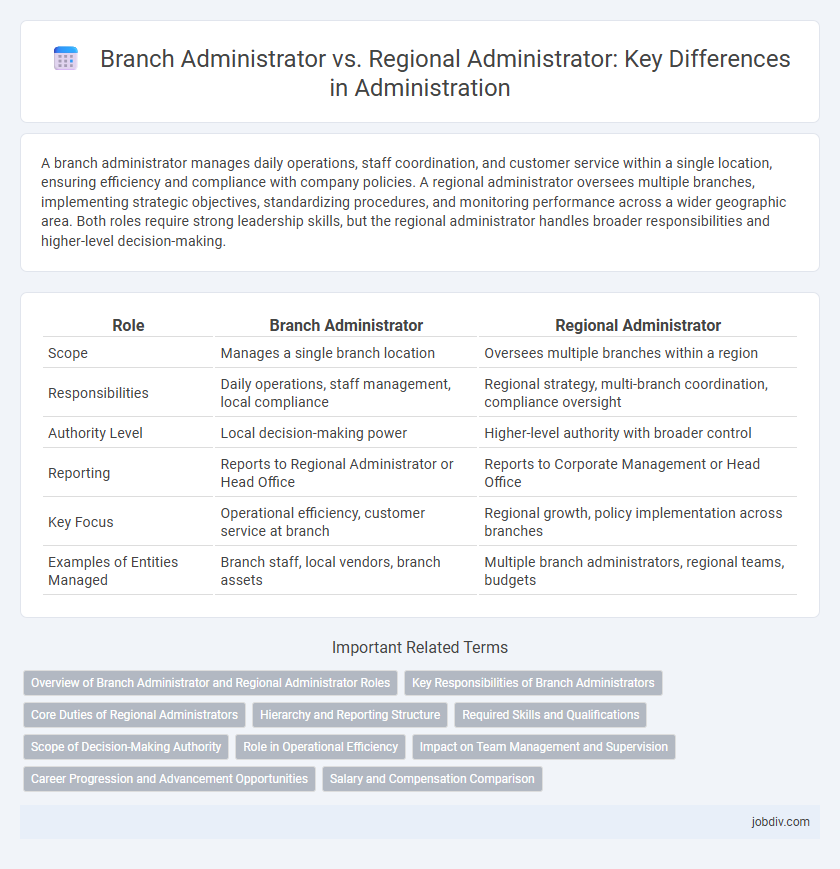A branch administrator manages daily operations, staff coordination, and customer service within a single location, ensuring efficiency and compliance with company policies. A regional administrator oversees multiple branches, implementing strategic objectives, standardizing procedures, and monitoring performance across a wider geographic area. Both roles require strong leadership skills, but the regional administrator handles broader responsibilities and higher-level decision-making.
Table of Comparison
| Role | Branch Administrator | Regional Administrator |
|---|---|---|
| Scope | Manages a single branch location | Oversees multiple branches within a region |
| Responsibilities | Daily operations, staff management, local compliance | Regional strategy, multi-branch coordination, compliance oversight |
| Authority Level | Local decision-making power | Higher-level authority with broader control |
| Reporting | Reports to Regional Administrator or Head Office | Reports to Corporate Management or Head Office |
| Key Focus | Operational efficiency, customer service at branch | Regional growth, policy implementation across branches |
| Examples of Entities Managed | Branch staff, local vendors, branch assets | Multiple branch administrators, regional teams, budgets |
Overview of Branch Administrator and Regional Administrator Roles
Branch administrators manage daily operations, supervise staff, and ensure compliance within individual branch locations. Regional administrators oversee multiple branches, coordinate strategies, and implement organizational policies across their designated geographic areas. Both roles require strong leadership and communication skills but differ in scope, with branch administrators focusing on localized tasks and regional administrators handling broader operational oversight.
Key Responsibilities of Branch Administrators
Branch administrators manage daily operations at individual office locations, ensuring compliance with corporate policies and local regulations. They oversee staff performance, resource allocation, and customer service to maintain branch efficiency and productivity. Key responsibilities include financial reporting, inventory management, and implementing training programs tailored to branch-specific needs.
Core Duties of Regional Administrators
Regional administrators oversee multiple branch locations, ensuring consistent implementation of company policies and standards across all sites. They coordinate strategic planning, resource allocation, and compliance auditing to optimize operational efficiency within their assigned region. Core duties include managing regional budgets, supervising branch administrators, and facilitating communication between headquarters and individual branches.
Hierarchy and Reporting Structure
A branch administrator manages the daily operations and reports directly to the regional administrator, who oversees multiple branches within a designated region. The regional administrator holds higher authority, coordinating branch administrators and aligning branch activities with corporate strategies. This hierarchical structure ensures streamlined communication and efficient supervision across localized and broader administrative levels.
Required Skills and Qualifications
Branch administrators require strong organizational skills, proficiency in local compliance regulations, and experience managing small to mid-sized teams to ensure smooth daily operations. Regional administrators must possess advanced leadership abilities, strategic planning expertise, and extensive knowledge of multi-location management to coordinate activities across multiple branches effectively. Both roles demand excellent communication skills and a solid understanding of budgeting and resource allocation.
Scope of Decision-Making Authority
A branch administrator typically has decision-making authority limited to operational, staffing, and budgetary matters within a single branch location, ensuring alignment with corporate policies. In contrast, a regional administrator possesses broader authority across multiple branches or offices within a defined geographic region, enabling strategic oversight, resource allocation, and policy implementation on a wider scale. This expanded scope allows regional administrators to influence regional performance metrics, coordinate cross-branch initiatives, and manage regional compliance requirements.
Role in Operational Efficiency
A branch administrator manages daily operations and staff performance within a specific location, ensuring streamlined workflows and quick issue resolution to boost local productivity. A regional administrator oversees multiple branches, coordinating resources and standardizing processes across locations to enhance broader operational consistency and efficiency. This hierarchical structure facilitates effective communication and resource allocation, driving overall organizational performance.
Impact on Team Management and Supervision
Branch administrators directly oversee daily operations and staff performance within a specific location, ensuring alignment with organizational goals and immediate problem resolution. Regional administrators manage multiple branches, coordinating strategies and standardizing policies across locations to drive consistent team performance and operational efficiency. Their impact on team management involves balancing localized supervision with broader oversight to optimize workforce productivity and cohesion across regions.
Career Progression and Advancement Opportunities
Branch administrators often begin their careers managing individual office operations, gaining hands-on experience in staff supervision, customer service, and daily administrative tasks. Regional administrators typically oversee multiple branch locations, requiring strategic planning, budget management, and leadership skills that reflect a higher level of responsibility and complexity. Career progression from branch to regional administrator involves developing expertise in cross-branch coordination, advanced decision-making, and organizational leadership, offering greater advancement opportunities and higher compensation.
Salary and Compensation Comparison
Branch administrators typically earn a salary ranging from $50,000 to $75,000 annually, depending on location and industry, with performance bonuses and benefits such as health insurance and retirement plans included. Regional administrators command higher compensation, often between $80,000 and $120,000 per year, reflecting broader managerial responsibilities and larger team oversight, with additional incentives like profit-sharing and executive benefits. Salary disparities also account for experience levels, organizational size, and geographic demand for administrative leadership roles.
branch administrator vs regional administrator Infographic

 jobdiv.com
jobdiv.com